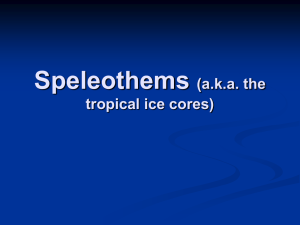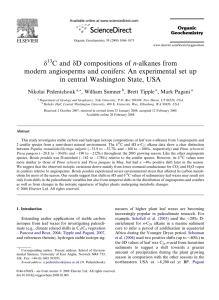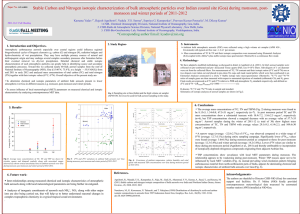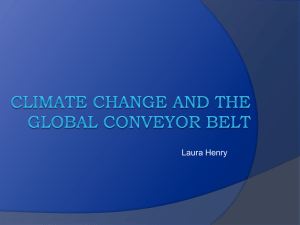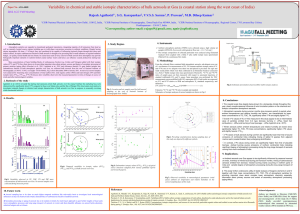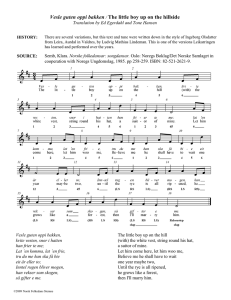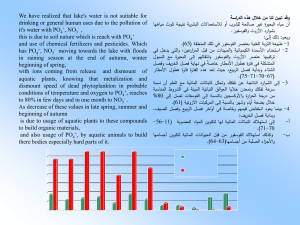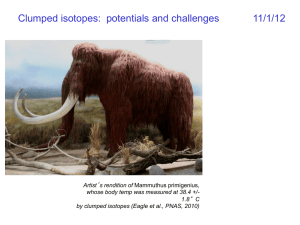Piotrowski
advertisement
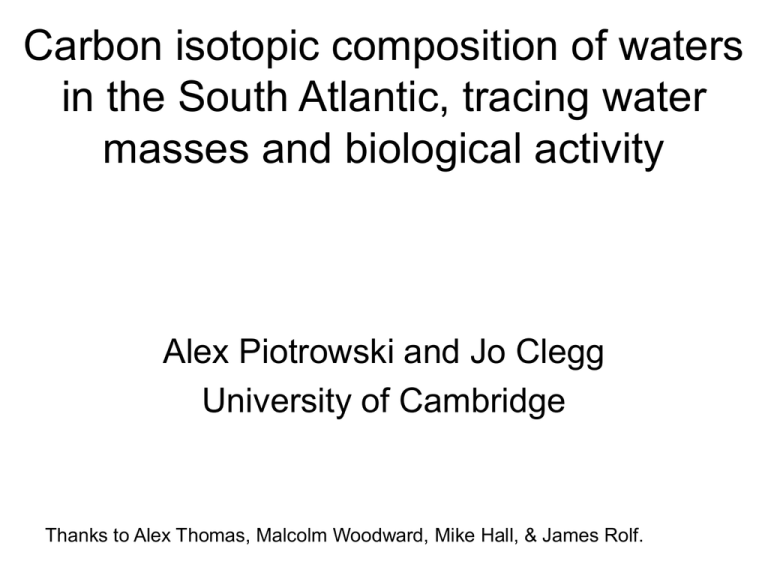
Carbon isotopic composition of waters in the South Atlantic, tracing water masses and biological activity Alex Piotrowski and Jo Clegg University of Cambridge Thanks to Alex Thomas, Malcolm Woodward, Mike Hall, & James Rolf. Holocene: Seawater d13C from GEOSECS and WOCE Glacial: Benthic foraminiferal d13C from various studies Curry and Oppo, 2005 Ravelo and Hillaire-Marcel, 2007 Integrating Nd and C isotopes Can Nd isotopes help to deconvolve the different signals contributing to the benthic d13C record? Benthic d13C → deep ocean circulation + carbon cycling + air-sea gas exchange Nd isotopes → deep ocean circulation + REE cycling Charles et al., 1996, Piotrowski et al., 2005 Site of those records… Lower Higher eNd and Higher d 13C eNd and Lower d 13C Site of those records… Mackensen 2012 Mackensen 2012 Methods • Samples collected early to minimize gas exchange, glass containers overfilled to prevent air bubbles. • Sealed poisoned (with mercuric chloride) seawater samples stored in refrigerator • Subsamples run on Thermo MAT253 mass spectrometer with Gas Bench d13C with depth for all stations (except 5) d13C (per mil) 0.40 0 0.90 1.40 1000 depth (m) 2000 3000 station 8 station9 station 1 station 2 station 10 station 3 station 4 station 11 station 6 station 7 Cruise D357 Cape Basin 4000 5000 6000 41S 18E depths 11 to 4395 Kroopnick 1980 has d13C -0.24 to 1.74‰ this is nearest to our station 7 which is (5 to 3531m) d13C -0.426-0.6‰ (so our d13C lower than this of Kroopnick’s; but similar sorts of values) d13C with depth for all stations (except 5) d13C (per mil) 0.40 0 near 0.90 coast 1.40 1000 depth (m) 2000 3000 station 8 station9 station 1 station 2 station 10 station 3 station 4 station 11 station 6 station 7 Cruise D357 Cape Basin 4000 5000 6000 41S 18E depths 11 to 4395 Kroopnick 1980 has d13C -0.24 to 1.74‰ this is nearest to our station 7 which is (5 to 3531m) d13C -0.426-0.6‰ (so our d13C lower than this of Kroopnick’s; but similar sorts of values) 13 (0.75) 8 (0.5) 9 (1.5) test 10 (2.5) 1 2 12 (3.5) 11ss (4.5) 4 7 6ss First leg Second leg 5 3ss The mechanism for removing the biological contribution from the d13C is due to Broecker and Maier-Reimer 1992. They find the 1.1 slope with PO4 and use the -2.7 , an arbitrary constant, to bring deep water values from Pacific and Indian Ocean to 0 ‰. d13Cas = d13C + (1.1 x PO4) -2.7 (1) Lynch-Stieglitz and Fairbanks (1994) adopted the notation d13Cas – ‘the air/sea exchange signature’: d13Cas = d13C - (2.7 - 1.7 x PO4) (2) Lynch-Stieglitz at al (1995) for Antarctic The numbers in this formula are not agreed. Other possibilities are: d13Cas = d13C - (1.92 - 0.7 x PO4) (3) d13Cas = d13C - (2.4 – 0.93 x PO4) (4) Mackensen et al (1993) taking the regression computed by Kroopnick (1985). But in more recent papers, Mackensen uses the Broecker and Maier-Reimer equation (1). Charles et al 1993 Here we use: d13Cas = d13C + (1.1 x PO4) -2.7 (1) and PO4 in μmol/L rather than μmol/kg, to match most studies. d13C air-sea for all stations (station 3 no line through as two important data points missing) depth near -2 coast-1.5 -1 -0.5 0 0.5 1 0 1000 station 8 d13C (air-sea) 2000 station9 station 1 station 2 3000 station 10 station 3 station 4 4000 station 11 station 5 station 6 5000 station 7 6000 Southern Ocean surface has highest d13Cas, sub tropical gyre waters usually ~ -1 ‰ We then confirm the water mass identification using conservative properties Salinity and Potential temperature Potential temperature (again leave out station 5 as so much data missing) 0 0 1000 1000 2000 2000 Depth (m) Depth (m) Salinity (again leave out station 5 as so much data missing) 3000 3000 4000 4000 5000 5000 6000 34 34.2 34.4 34.6 34.8 35 Salinity (psu) 35.2 35.4 35.6 35.8 station 8 station 9 station 1 station 2 station 10 station 3 station 4 station 11 station 6 station 7 schneidl max schneidl min 6000 0.0000 5.0000 10.0000 15.0000 20.0000 Temp (deg C) Max and Min for NADW: Pink lines Schmiedl at al 1997 Grey lines Kroopnick 1980a Max and Min for NADW: Dashed lines Schmiedl at al 1997 d13C air-sea for all stations (station 3 no line through as two important data points missing) horizontal lines: blue NADW, pink AAIW, green LCDW d13C (air-sea) -2 -1.5 -1 -0.5 0 1000 AAIW depth 2000 3000 NADW 4000 AABW 5000 6000 0 0.5 1 Comparison of eastern and western South Atlantic profiles Red = west of mid-Atlantic Ridge Blue = east of mid-Atlantic Ridge blue - east of MAR; red - west of MAR d13C (per mil) 0.00 0 1000 depth (m) 2000 3000 4000 5000 6000 0.50 1.00 1.50 2.00 2.50 Comparison of eastern and western South Atlantic profiles Red = west of mid-Atlantic Ridge Blue = east of mid-Atlantic Ridge blue - east of MAR; red - west of MAR d13C (per mil) 0.00 0 1000 depth (m) 2000 3000 4000 5000 6000 0.50 1.00 1.50 2.00 2.50 blue - east of MAR; red - west of MAR; triangles - silica d13C 0.00 0 0.50 1.00 1.50 2.00 2.50 1000 depth (km) 2000 3000 d13C dissolved silica 4000 5000 6000 0 50 100 Silica 150 200 blue - east of MAR; red - west of MAR PO4 triangles d13C 0.00 0.50 1.00 1.50 2.00 2.50 0 1000 depth (m) 2000 3000 PO4 d13C 4000 5000 6000 0 0.5 1 1.5 PO4 2 2.5 3 d13C air sea (per mil) -2.0 -1.5 -1.0 -0.5 0.0 0.5 1.0 depth (m) 0 1000 Blue East of mid-Atlantic ridge 2000 Yellow D357 cruise 3000 Red West of mid-Atlantic ridge 4000 5000 6000 Red = west of mid-Atlantic Ridge Blue = east of mid-Atlantic Ridge d13C air-sea -2.00 -1.00 0.00 1.00 2.00 0 1000 aaiw depth (m) 2000 3000 4000 5000 6000 nadw lcdw weddell sea deep water? WSDW from Provost et al, 1990 depth in Argentine Basin 4500-6000 vertical lines potential temp values for cape basin aaiw max min green nadw violet lcdw pink depth ranges shown determined for D357 salinity pss 34.0 0 1000 34.5 35.0 35.5 potential temp 36.0 36.5 37.0 -5 4000 10 15 20 25 1000 aaiw aaiw cape basin 2000 nadw lcdw 5000 depth depth 5 0 2000 3000 0 nadw cape basin 3000 4000 5000 6000 lcdw cape basin 6000 Red = west of mid-Atlantic Ridge Blue = east of mid-Atlantic Ridge 30 Comparison with data of Lynch-Stieglitz et al 1995 1.50 1.00 d13Cas 0.50 0.00 -0.50 1.00 1.50 2.00 2.50 3.00 PO4 (mmol/kg) Added Mackensen 1993 data as white squares. WOCE A10 track 25S to 25S Data from JC068 stations 8-21 Mackensen (2012) Bottom water values AAIW lat/long water d13C depths only 1000-2000 (AAIW in Cape Basin) South 30E 390 Africa -20 120W 240 70W 290 20W 340 -30 long (S) -40 d13C -ve South America 0-0.2 0.2-0.4 Our coretop values on benthic forams are 1.24 ‰ while overlying seawater is 0.73 ‰ 0-4-0.6 -50 0.6-0.8 0.8-1 -60 ours 0.4--0.6 -70 ours 0.6--0.8 -80 lat (recall 0=360) lat/long water d13C air-sea depths only 1000-2000 (AAIW in Cape Basin) -20 120W 240 d13Cas 70W 290 20W 340 -30 long (S) -40 -50 South Africa 30E 390 -ve South America 0-0.2 0.2-0.4 0-4-0.6 ours 0.2-0.4 -60 ours 0.4-0.6 -70 Triangles: our values Squares: Mackensen 2012 -80 lat (recall 0=360) NADW lat/long water d13C depths only 2000-3500 (NADW in Cape Basin) long (S) -20 120W 240 100W 260 -30 -40 80W 280 60W 300 40W 320 20W 340 0 360 South 40E 400 Africa 20E 380 60E 420 Our coretop values on benthic forams are 0.85 ‰ while d13C overlying seawater is 0.90 ‰ -ve 0-0.2 South America 0.2-0.4 0-4-0.6 -50 0.6-0.8 -60 0.8-1 0.2-0.4 ours -70 0.6-0.8 ours -80 0.8-1 ours lat (recall 0=360) lat/long water d13Cair-sea depths only 2000-3500 (NADW in Cape Basin) -20 120W 100W 240 260 -30 d13Cas long (S) -40 -50 80W 280 60W 300 40W 320 20W 340 South America 0 360 20E 380 40E 60E 400 420 South Africa 0-0.2 0.2-0.4 0-4-0.6 0--0.2 ours -60 0.2-0.4 ours -70 Triangles: our values Squares: Mackensen 2012 -80 lat (recall 0=360) LCDW lat/long water d13C depths only below 3500 (LCDW in Cape Basin) -20 240 260 120W 100W -30 long (S) -40 -50 280 80W 300 60W 320 40W 340 20W 360 0 South 400 40E Africa 380 20E RC11-83 benthic d13C has a “coretop” (~5ka) 13 d C value of 0 ‰ 420 -ve 0-0.2 South America 0.2-0.4 Cape Basin bottomwater is clearly more positive 0-4-0.6 0.6-0.8 0.8-1 -60 ours 0.2--0.4 -70 ours 0.4--0.6 ours 0.6--0.8 -80 ours 0.8--1 lat (recall 0=360) lat/long water d13C air-sea depths only below 3500 (LCDW in Cape Basin) -20 120W 100W 240 260 80W 280 60W 300 40W 320 20W 340 -30 -40 long (S) d13Cas -50 0 360 20E 380 South 40E 60E 400 420 Africa -ve 0-0.2 South America 0.2-0.4 0-4-0.6 0.6-0.8 0.8-1 ours 0--0.2 -60 ours 0.2--0.4 ours 0.4--0.6 -70 ours 0.6--0.8 Triangles: our values Squares: Mackensen 2012 -80 lat (recall 0=360) Conclusions • Seawater d13C clearly shows water mass structure, both surface hydrography and deep water. • Air-sea exchange component of strong d13C gradient in surface ocean near Agulhas likely has subtropical (Indian) source. • The d13C offset at NADW/AABW boundary in west is shallower than in east • Nutrient signal? May not appear in d13C air-sea exchange component. Need to check potential density. • Coretop calibration to benthic foraminifera d13C remains questionable. -ve lat/long water d13C with forams superimposed 0-0.2 0.2-0.4 long (S) -20 240 -30 0-4-0.6 260 280 300 320 340 360 380 400 420 0.6-0.8 0.8-1 forams -ve -40 forams 0-0.2 -50 forams 0.2-0.4 -60 forams 0.4-0.6 forams 0.6-0.8 -70 forams 0.8-1 forams >1 -80 lat (recall 0=360) ours 0.8-1 ours >1 These are all Mackensen 2012 data for d13C of forams in coretops vs d13C in bottom water. And now we can add our two more – the big stars! They don’t seem to match much but then neither do Mackensens. lat/long water d13C with forams superimposed -ve 0-0.2 0.2-0.4 -20 240 -30 0-4-0.6 260 280 300 320 340 360 380 400 0.6-0.8 420 0.8-1 forams -ve forams 0-0.2 long (S) -40 forams 0.2-0.4 -50 forams 0.4-0.6 forams 0.6-0.8 -60 forams 0.8-1 forams >1 -70 ours 0.8-1 ours >1 -80 lat (recall 0=360) our w ater 0.6-0.8 our w ater 0.8-1 And the big circles are our bottom water samples just above the forams. (Note very few of Mackensens data have water taken just above the forams) Worksheets provided • • • • • • ‘jo's current look at results-xtra DIC’ ‘jo's current look at results’ ‘just before Oxford jc068 geotraces’ jc068 geotraces jc068 geotraces TDD and try for final AAIW 500-2000 NADW 2000-3500 LCDW below 3500 So we find d13Cair-sea AAIW -0.55 to 0.1‰ NADW 0.21 to 0.42‰ LCDW 0.19 to 0.77‰ Comparisons with other data: Working out d13Cas using PO4 and d13C of Mackensen 1993 at 44S 10.3E AAIW 0.52 to 0.59‰ NADW 0.003 to 0.053‰ LCDW -0.11 to 0.022‰ The discrepancy in values is disappointing as I worked them out. I have checked the units and they seem to be the same – umol/L. Lynch-Stieglitz and Fairbanks 1994 had d13Cair-sea for Atlantic all negative (their values were from Cd not PO4) and I can’t see where they get their modern ocean values from. We could perhaps say our values will be higher, being pulled up by mixing with positive Antarctic. But surely not this much. ( Mackensen 2012 says NADW characterised by negative d13Cair-sea, despite the values above 0.003 to 0.053‰) surface (highest value we have) d13C vs PO4 2.5 d13C 2 1.5 1 0.5 0 0 0.2 0.4 0.6 0.8 1 1.2 PO4 For surface waters our d13C and PO4 values are similar to Broecker and Maier-Reimer S Atlantic; despite possibly having more anthropogenic effects that are not accounted for. (We don’t have their very high phosphate level ones.) This suggests our values of d13Cas are different to other work because I have calculated the equation wrong. But I’ve checked several times! Note the values of d13Cas are similar to those of mackensen 2012 –slides at end If we decide to use this slide it needs redoing and to be put somewhere else as it uses JC068 cruise data and up to now all we have discussed is D357 d13C vs DIC concentration for all stations grey shallow, blue deep 1 station 8 station 1 deep station 1 shallow station 9 deep station 9 shallow station 2 deep station 2 shallow station 10 deep station 10 shallow station 3 deep station 3 shallow station 4 deep station 4 shallow station 5 deep station 5 shallow station 7 deep station 7 shallow station 6 deep station 6 shallow 0.5 d13C air sea 0 -0.5 -1 -1.5 -2 2000 2100 2200 2300 2400 2500 DIC As we have not got DIC for second cruise perhaps delete this slide? Green max min of AAIW; pink of NADW; blue of LCDW from Schmiedl at al 1997 for Cape Basin 28 26 24 22 20 potential temp 18 16 ) 14 12 Figures below right: Provost et al 1990 for Argentine Basin Left: Memery 2000 for southwest Atlantic 10 8 6 4 AAIW AAIW 2 0 -2 33.000 LCDW NADW NADW LCDW 34.000 35.000 salinity pss 36.000 37.000 WOCE A11 track 30S to 45S WOCE A10 track 25S to 25S WOCE A10 track 25S to 25S Data from JC068 stations 8-21 So the PO4 and potential temp data agree quite well with WOCE. But we have problems that it does not lay on Lynch Steiglitz fig 6 – next slide
